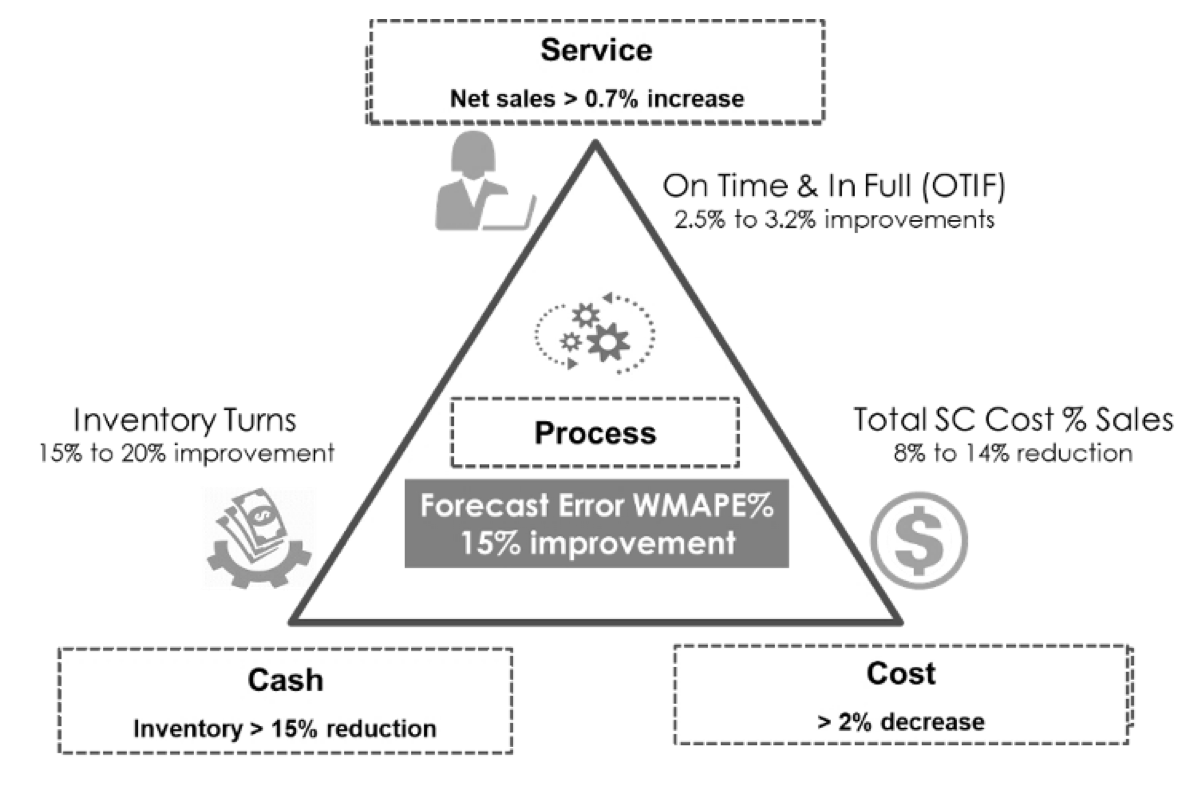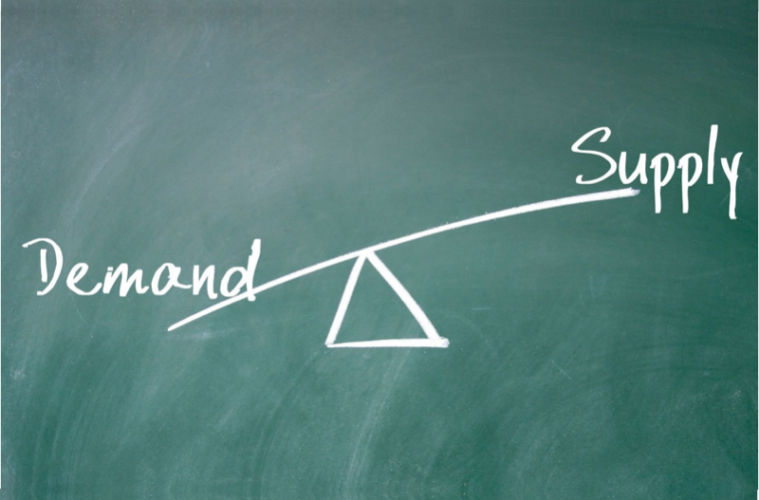In today’s volatile and uncertain market, companies can no longer afford to operate without a structured, data-driven approach to forecasting demand. Demand planning is more than just predicting sales—it’s about building an integrated, agile business that can respond to customer needs while managing resources efficiently. Despite its importance, many organizations still rely on outdated tools, such as spreadsheets, which can lead to bias and siloed decision-making, ultimately compromising their forecast accuracy.
The potential improvements in predictive analytics and the integrated demand planning process can significantly streamline decision-making processes, create new insights, and save several business functions a huge amount of time and money.
Understand that a business will most likely invest in a new process to solve pain points, drive quantified savings, or deliver other clearly defined improvements. To successfully build a business case, you need to both help the organization understand the need and see the benefits.
Why Focus on Demand Planning?
Most companies that decide to invest or improve their process are primarily driven by one or more of the following:
- Obvious forecast accuracy challenges
- A highly variable process that requires a dedicated process to support it
- Detail-level forecasts are needed to support a more efficient manufacturing or distribution system
- Downstream inventory problems that are clearly driven by unseen variability
- An attempt to drive more cooperation between Sales and Operations through a consensus-based planning.
At its core, demand planning acts as the foundation for synchronized operations. It allows marketing, sales, supply chain, finance, and production to operate from a common set of assumptions. Without an accurate demand plan, supply planning becomes reactive; finance struggles with forecasting revenue, and customer service deteriorates due to stockouts or excess inventory.
Consumer behaviors have become increasingly unpredictable. Economic shifts, global disruptions, and rapid product cycles mean that relying solely on historical sales is no longer sufficient. Demand planning introduces a proactive lens that incorporates both internal drivers (such as promotions and price changes) and external signals (including market trends and customer insights) to create adaptive forecasts.
Inaccurate demand forecasts result in costly outcomes, including expedited shipping, excess working capital, lost sales, and markdowns. Improved demand planning helps reduce forecast error, allowing for better inventory placement, production planning, and supplier coordination. Even a 5- to 10-percent improvement in forecast accuracy can have a significant bottom-line impact.
Potential Improvements in Demand Planning
Organizations that invest in improving demand planning benefit from:
- Reduced Inventory Costs – Through better alignment of supply and demand.
- Improved Service Levels – By placing the right product in the right place at the right time.
- Higher Forecast Accuracy – Leading to more reliable plans across finance and supply.
- Faster Decision-Making – Enabled by real-time data and scenario analysis.
- Greater Agility – Ability to adjust to shifts in demand or supply quickly.
A mountain of research today shows that a mature demand planning process helps in improving forecast accuracy and delivers a high ROI. Improved forecast accuracy, when combined with software that translates the forecast into actionable insights, will decrease inventory and operating costs, increase service and sales, enhance cash flow and gross margin return on inventory investment (GMROI), and boost pre-tax profitability. The forecasting error, no matter how small, has a significant impact on the bottom line. In our experience, a 15 percent improvement in forecast accuracy will deliver a pre-tax improvement of 3 percent or higher.
In a previous IBF study of 15 U.S. companies, we found that even a one percentage point improvement in under-forecasting at a $1 billion company results in a savings of as much as $1.52 million, and for the same amount of improvement in over-forecasting, $1.28 million.[i]
The reduction in downstream finished goods inventory resulting from a well-established process and forecast accuracy improvements provides a one-time saving, as well as recurring savings arising from reduced carrying costs. There are significant benefits in a make-to-stock or distribution company. The downstream inventory reduction could range from 10 percent to 20 percent, as forecasting inaccuracies typically account for around 75 percent of the required safety stock.
Building and Investing in Demand Planning
- Build an Unbiased, Unconstrained, Consensus-Based Forecast: Organizations often confuse the demand plan with the sales target. Sales may overestimate to push for stretch goals, while operations may buffer to protect service. Demand planning needs to separate judgment from aspiration. Instituting a formal demand consensus process ensures that all voices are heard, while forecasts remain grounded in data and are evaluated against actual performance.
- Upgrade from Static Spreadsheets to Dynamic Models: Many companies still use Excel as their primary planning tool. While familiar, spreadsheets lack scalability, version control, and real-time integration. Upgrading to a dedicated demand planning system (or enhancing existing tools with forecasting models) introduces automation, improves collaboration, and enables real-time adjustments. It also supports more advanced techniques such as decomposition models or AI-based forecasts.
- Understand and Match Models to Patterns: Not all items follow the same demand pattern. Some are seasonal, some have trends, and others are highly volatile. Applying a one-size-fits-all model can lead to overfitting or underperformance. Instead, classify SKUs by their demand characteristics and apply the appropriate model, whether that’s exponential smoothing, moving average, or more complex causal models.
- Focus on Data Quality and Forecastability: Forecasting is only as good as the data behind it. Cleanse data for outliers, missing periods, and promotions. Measure forecastability using the Coefficient of Variation (CV) or Demand Intermittency. The demand planner becomes the integrator, ensuring that inputs from various departments are translated into a structured forecast. Establish accountability through KPIs such as bias, MAPE, and forecast value added (FVA).
- Invest in training and upskilling through IBF: Empower your teams with proven forecasting and planning knowledge by leveraging IBF’s certifications, workshops, and learning resources, building internal capability that drives consistent, confident decision-making.
Many companies are leaving money on the table with lost sales or poor service levels. An integrated demand planning process can result in increased revenue of 0.5 percent to 3 percent, along with improved inventory availability and demand shaping capabilities. Total annual direct material purchases, along with logistics-related expenses arising from demand variability and lost opportunities, can see direct improvements of 3 percent to 5 percent. We can also benefit from a 20 percent reduction in airfreight costs. Figure Y illustrates the anticipated benefits from a 15 percent improvement in forecast accuracy (these averages are based on individual results, which can vary depending on other variables and may be higher or lower for specific organizations).

Fig. Y | Graphic showing typical benefits from a 15 percent improvement in forecast accuracy
It is essential to understand these average savings amounts and determine what savings you believe you can achieve with a mature predictive analytics and demand planning process. Sometimes you need to know what finance and executive leadership anticipate in terms of benefits; you need to be on the same page in terms of expectations. It is here that the Institute of Business Forecasting Advisory Services (IBF.org) can shed some light on what is realistic based on past implementations.
Demand planning is not just a supply chain function; it’s a strategic business process that empowers smarter, faster decisions. In an environment where disruption is the norm and expectations are high, companies that implement disciplined, data-driven demand planning will not only survive, they will lead.
The path forward is clear: Separate judgment from strategy, invest in tools and talent, and build a collaborative process that evolves with your business.
In a world of uncertainty, demand planning offers clarity. It’s not just about predicting the future, it’s about preparing for it. Companies that invest in robust, unbiased, and collaborative demand planning are the ones that outperform, outmaneuver, and outlast their competition.
But you don’t have to do it alone.
The Institute of Business Forecasting (IBF) has been the trusted authority in forecasting, demand planning, and Sales and Operations Planning (S&OP) for over four decades. Whether you’re just starting your planning journey or looking to refine and elevate your process, IBF offers the training, certification, tools, and global community to help you succeed.
Join IBF and take the next step:
- Get certified with globally recognized credentials
- Attend industry-leading conferences and events
- Access exclusive research, case studies, and best practices
- Learn from and connect with top planning professionals around the world
[i] Chaman L. Jain (2018). The Impact of People and Processes on Forecast Error in S&OP. IBF research report #18. August 31, 2018

